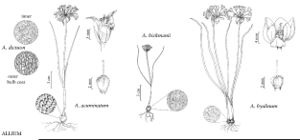Allium acuminatum
Fl. Bor.-Amer. 2: 184, plate 196. 1838.
Bulbs 1–12+, not basally clustered, not forming rhizomes, ovoid to ± globose, 0.8–1.6 × 0.9–1.6 cm; outer coats enclosing 1 or more renewal bulbs, ± yellow-brown, prominently cellular-reticulate, membranous, cells square or polygonal, walls thick, obscurely sinuous, without fibers; inner coats white, cells obscure, ± quadrate. Leaves persistent, withering from tip by anthesis, 2–3, basally sheathing, sheaths not extending much above soil surface; blade solid, subterete or ± channeled, 7–30 cm × 1–3 mm, margins entire. Scape persistent, solitary, erect, solid, terete, 10–35 cm × 1–3 mm. Umbel persistent, erect, loose, 10–40-flowered, hemispheric, bulbils unknown; spathe bracts persistent, 2, 3–7-veined, lanceolate to ovate, ± equal, apex acuminate. Flowers campanulate, 8–15 mm; tepals erect, pink to rose-purple, or white, lanceolate to lance-ovate, unequal, becoming rigid and keeled in fruit, margins finely denticulate (inner tepal more prominently so), apex acuminate, outer tepal longer and wider than inner, spreading to recurved at tip, inner tepal with strongly recurved tips; stamens included; anthers yellow; pollen yellow; ovary crested; processes 3, central, 2-lobed, rounded, minute, margins entire; style linear, equaling stamens; stigma capitate, scarcely thickened, obscurely 3-lobed; pedicel 6–25 mm. Seed coat dull or shining; cells minutely roughened. 2n = 14.
Phenology: Flowering Apr–Jul.
Habitat: Dry slopes and plains
Elevation: 100–1500 m
Distribution

B.C., Ariz., Calif., Colo., Idaho, Nev., Oreg., Utah, Wash., Wyo.
Discussion
Selected References
None.
